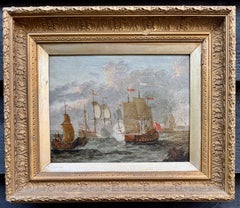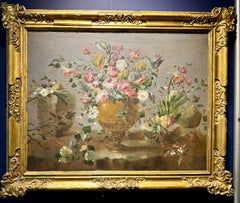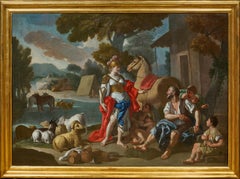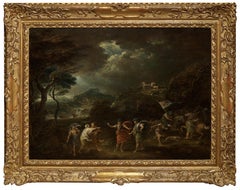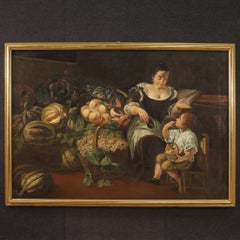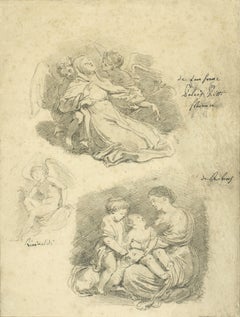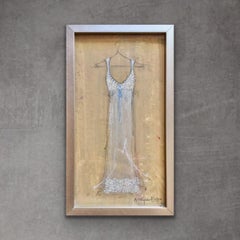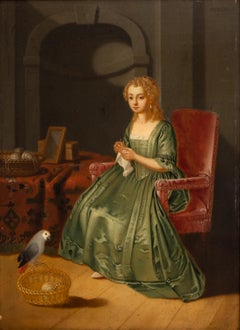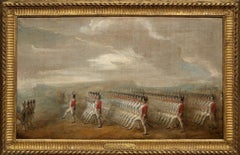1760s Figurative Paintings
to
2
1
3
4
Overall Width
to
Overall Height
to
976
2,406
13,261
30,522
285
286
564
780
573
764
917
980
1,031
1,011
471
4
7
3
8
5
5
2
2
1
1
1
1
1
1
9
9
7
7
2
1
1
1
9
8
2
Period: 1760s
18th century English marine Battle scene between Dutch and British warships
By Francis Swaine
Located in Woodbury, CT
Attributed to Francis Swaine (British, 1725–1782)
Naval Engagement at Sea, 18th century
Oil on panel
In this evocative seascape, a cluster of ships—flags raised, cannons fired—conve...
Category
Old Masters 1760s Figurative Paintings
Materials
Oil, Wood Panel
18th century Venetian Still life of flowers, classical vase on a marble ledge
Located in Woodbury, CT
The Pseudo-Guardi was an unidentified Venetian painter from the 18th or early 19th century who closely imitated the style of Francesco Guardi (1712–1793), one of the great Venetian v...
Category
1760s Figurative Paintings
Materials
Canvas, Oil
Erminia and the Shepherds, a painting by Francesco de Mura (Napoli 1696 - 1782)
Located in PARIS, FR
In this masterly painting, Francesco de Mura presents the meeting of Erminia and the shepherds, a famous episode taken from the seventh canto of Torquato Tasso's Jerusalem Delivered....
Category
Old Masters 1760s Figurative Paintings
Materials
Canvas, Oil
Macbeth and the Three Witches a Painting on Panel by Francesco Zuccarelli
Located in PARIS, FR
This painting, created during Zuccarelli's stay in England, represents the decisive moment when Macbeth, together with Banquo, meets the three witches who announce that he will be Ki...
Category
Old Masters 1760s Figurative Paintings
Materials
Oil, Wood Panel
18th Century Oil on Canvas Italian Antique Painting Genre Scene with Still Life
Located in Vicoforte, IT
Antique Italian painting from the 18th century. Artwork oil on canvas depicting a genre scene with greengrocer and still life of good pictorial quality. Painting of exceptional size ...
Category
1760s Figurative Paintings
Materials
Canvas, Oil
Three studies executed in the Pitti Palace in 1761 by Jean-Honoré Fragonard
Located in PARIS, FR
This brilliant study sheet, of which we present here a counterproof, is a souvenir of Fragonard's return journey from Italy. Between April and September 1761, he accompanied the abbot of Saint-Non on his way back to France. Three studies after the masters taken from the Pitti Palace’s gallery in Florence are gathered on this sheet. Although The Ecstasy of Saint Margaret...
Category
Old Masters 1760s Figurative Paintings
Materials
Carbon Pencil
18th Century Oil on Canvas Italian Landscape Painting Pastoral Scene, 1760
Located in Vicoforte, IT
Antique Italian painting from the 18th century. Artwork oil on canvas depicting a bucolic landscape, pastoral scene with chariot of good pictorial quality. Small painting adorned wit...
Category
1760s Figurative Paintings
Materials
Canvas, Oil
18th Century Biblical Scene Italian School Saint Joseph Oil on Canvas Brown Gold
Located in Sanremo, IT
Painting oil on canvas depicting a soldier handing the crown to Saint Joseph, measuring 76 x 61 cm without frame and 95 x 80 cm with frame by an Italian School of the second half of ...
Category
Italian School 1760s Figurative Paintings
Materials
Canvas, Oil
Portrait of a priest Prémontré
Located in BELEYMAS, FR
French school around 1760
Portrait of a Premonstratensian
Oil on canvas
H. 81 cm ; W. 65 cm
Traces of signature at the top left
Provenance: Private collection, Versailles
While the...
Category
French School 1760s Figurative Paintings
Materials
Canvas, Oil
18th Century Oil on Canvas Italian Antique Landscape Painting Genre Scene, 1760
Located in Vicoforte, IT
Antique Italian painting from the 18th century. Oil on canvas artwork depicting a particular classic genre scene on a bucolic landscape of good pictorial quality. Painting of good si...
Category
1760s Figurative Paintings
Materials
Canvas, Oil
Related Items
Nightie Night - 5"x9", Small Framed Artwork, White, Beige, Feminine
Located in Mississauga, Ontario
A soft neutral palette used in this artwork adds to the graceful, feminine quality of the subject matter. Focus is placed on the blending of delicate detail and expressive brush wor...
Category
Contemporary 1760s Figurative Paintings
Materials
Acrylic, Pencil, Illustration Board
$540 Sale Price
20% Off
H 13 in W 23 in D 2.5 in
Fine 1700's Italian Old Master Ink & Wash Drawing Roman Allegorical Providenza
Located in Cirencester, Gloucestershire
'Providenza'
Italian School, 18th century
ink and wash drawing on paper, framed within a light oak wood frame (behind glass)
image size: 10.5 x 7 inches
overall framed: 17 x 13 inche...
Category
Old Masters 1760s Figurative Paintings
Materials
Ink, Watercolor, Archival Paper
$484 Sale Price
30% Off
H 17 in W 13 in
Shipping in Calm Waters, 18th Century Dutch Oil on Wood Panel, Man o War
Located in Cirencester, Gloucestershire
Shipping in Calm Waters
Dutch School, 18th century
oil painting on wood panel
panel: 10 x 12.75 inches
framed: 14 x 17 inches
condition: very good, minor evidenc...
Category
Old Masters 1760s Figurative Paintings
Materials
Oil, Wood Panel
$2,155 Sale Price
30% Off
H 14 in W 17 in D 1 in
The Road to Emmaus, German Old Master Painting
Located in Stockholm, SE
German School, 1700s
The Road to Emmaus
oil on panel
unframed: 24.3 x 17.5 cm (9.6 x 6.9 inches)
framed: 34.5 x 28 cm (13.6 x 11 inches)
Provenance:
Swedish author and artist Amel...
Category
Old Masters 1760s Figurative Paintings
Materials
Oil, Wood Panel
"Umbria" Ornate Bowl with Figs Still Life Oil Painting
Located in Denver, CO
Victoria Novak’s "Umbria," a 2012 oil on canvas, is an intimate portrayal of still life that measures 15.70 x 15.70 inches, enclosed in a frame that bri...
Category
Photorealist 1760s Figurative Paintings
Materials
Canvas, Oil
$1,520 Sale Price
20% Off
H 15.7 in W 15.7 in
18th Oil Painting Horses Feeding at the Stables
Located in London, GB
James Seymour (1702–1752)
Feeding Time in the Stables
Oil on canvas
32 x 38 inches inc. frame
Provenance: Private Collection, Lambourn
James Seymour (1702–1752) was an English painter, widely recognized for his equestrian art.
Seymour was born in London. His father was an amateur artist and art dealer, whose other business dealings (as a banker, goldsmith, and diamond merchant) afforded young Seymour the leisure time to study art on his own, either his father's or the art at the Virtuosi Club of St. Luke - a gentleman's club his father belonged to, specializing in art. In a short time the boy was a self-taught artist, familiar with many of the prominent artists of the period.
Seymour's love of art was matched only by his love of horses. He began spending time at racetracks early on, and before long found himself absorbed in the sport - drawing, painting, owning, breeding, and racing horses. His art proved popular among the prominent sporting families of the day, eventually garnering Seymour patrons in Sir William Jolliffe and Charles Seymour, 6th Duke of Somerset...
Category
Old Masters 1760s Figurative Paintings
Materials
Oil
Fine 1700's Italian Old Master Ink & Wash Drawing Roman Allegorical Africa
Located in Cirencester, Gloucestershire
'Africa'
Italian School, 18th century
ink and wash drawing on paper, framed within a light oak wood frame (behind glass)
image size: 10.5 x 7 inches
overall framed: 17 x 13 inches
co...
Category
Old Masters 1760s Figurative Paintings
Materials
Ink, Watercolor, Archival Paper
$484 Sale Price
30% Off
H 17 in W 13 in
The Knight - painting - XVII century
Located in Roma, IT
The Knight is an original oil painting on canvas realized during the XVII century by an anonymous artist.
Provenance: Pecci-Blunt collection. Good condition...
Category
Old Masters 1760s Figurative Paintings
Materials
Canvas, Oil
17th century follower of Rubens, two military men on horse back in a landscape
Located in Woodbury, CT
17th century English/Dutch School, from the Circle of Sir Peter Paul Rubens
A very interesting and well-painted 17th-century oil on canvas of two men seated on horseback in a landsc...
Category
Old Masters 1760s Figurative Paintings
Materials
Canvas, Oil
$8,050 Sale Price
30% Off
H 16 in W 22 in
FINE 18th CENTURY OLD MASTER CHALK DRAWING - ROMANESQUE FIGURES INTERIOR SCENE
Located in Cirencester, Gloucestershire
Artist/ School: French School, 18th century
Title: Classical figures within an interior.
Medium: chalk on paper, mounted.
Size: drawing: 11.5 x 13.5 inches
Provenance:...
Category
Old Masters 1760s Figurative Paintings
Materials
Chalk
$930 Sale Price
30% Off
H 11.5 in W 13.5 in
Shipping in Stormy Waters, Attributed to Italian Artist Francesco Guardi
By Francesco Guardi
Located in Stockholm, SE
The splendour of the tragic sea
Francesco Guardi and maritime painting in Venetian art
No Venetian painter was a stranger to the sea. After all, Venice was not only one of the most prominent ports of the Mediterranean, but indeed a city literally submerged in the ocean from time to time. Curiously however, the famous Venetian school of painting showed little interest in maritime motifs, favouring scenes from the iconic architecture of the city rather than seascapes. That is why this painting is a particularly interesting window into not only the painter Francesco Guardi himself – but to the significance of the element of water in art history, in absence as well as in the centre of attention.
Whether it be calm, sunny days with stunning views of the palaces alongside the canals of Venice or – more rarely – stormy shipwrecking tragedies at sea, water as a unifying element is integral to the works of painter Francesco Guardi (1712–1793). During his lifetime, Venetian art saw many of its greatest triumphs with names like Tiepolo or Canaletto gaining international recognition and firmly establishing Venice as one of the most vibrant artistic communities of Europe. While the city itself already in the 18th century was something of an early tourist spot where aristocrats and high society visited on their grand tour or travels, the artists too contributed to the fame and their work spread the image of Venice as the city of romance and leisure to an international audience, many of whom could never visit in person.
Still today, the iconic image of Venice with its whimsical array of palaces, churches and other historic buildings is much influenced by these artists, many of whom have stood the test of time like very well and remain some of the most beloved in all of art history. It was not primarily subtility, intellectual meanings or moral ideals that the Venetian art tried to capture; instead it was the sheer vibrancy of life and the fast-paced city with crumbling palaces and festive people that made this atmosphere so special. Of course, Venice could count painters in most genres among its residents, from portraiture to religious motifs, history painting and much else. Still, it is the Vedutas and views of the city that seems to have etched itself into our memory more than anything else, not least in the tradition of Canaletto who was perhaps the undisputed master of all Venetian painters.
Born into his profession, Francesco lived and breathed painting all his life. His father, the painter Domenico Guardi (1678–1716) died when Francesco was just a small child, yet both he and his brothers Niccolò and Gian Antonio continued in their fathers’ footsteps. The Guardi family belonged to the nobility and originated from the mountainous area of Trentino, not far from the Alps. The brothers worked together on more challenging commissions and supported each other in the manner typical of family workshops or networks of artists. Their sister Maria Cecilia married no other than the artist Giovanni Battista Tiepolo himself, linking the family to the most renowned Venetian name of the time. During almost a decade, Guardi worked in the studio of Michele Giovanni Marieschi, sometimes simply known as Michiel, a painted similar in both style and motif. Canaletto is, however, the artist Guardi is most often compared to since they shared a mutual fascination for depicting the architecture and cityscape of Venice.
During the course of his career, Guardi tried his hand in many different genres. He was as swift in painting landscapes, Vedutas of Venice, sacred motifs, interiors and architectural compositions as he was in a number of other motifs. His style is typical of the Venetian school but also distinct and personal once we look a little closer. There is an absolute certainty in the composition, the choice of which sometimes feels like that of a carefully calculated photograph – yet it is also very painterly, in the best sense of the word: fluid, bold, sensitive and full of character. The brushwork is rapid, intense, seemingly careless and extraordinarily minute at the same time; fresh and planned in a very enjoyable mixture. His interiors often capture the breath-taking spacious glamour of the palaces and all their exquisite decor. He usually constructed the motif through remarkably simple, almost spontaneous yet intuitively precise strokes and shapes. The result was a festive, high-spirited atmospheric quality, far away from the sterile and exact likeness that other painters fell victim to when trying to copy Canaletto.
The painting here has nothing of the city of Venice in it. On the contrary, we seem to be transported far away into the solitary ocean, with no architecture, nothing to hold on to – only the roaring sea and the dangerous cliffs upon which the ships are just moments away from being crushed upon. It is a maritime composition evoking both Flemish and Italian precursors, in the proud tradition of maritime painting that for centuries formed a crucial part of our visual culture.
This genre of painting is today curiously overlooked, compared to how esteemed and meaningful it was when our relationship to the sea was far more natural than it is today. When both people and goods travelled by water, and many nations and cities – Venice among them – depended entirely on sea fare, the existential connection to the ocean was much more natural and integrated into the imagination. The schools and traditions of maritime art are as manifold as there are countries connected to the sea, and all reflect the need to process the dangers and wonders of the ocean.
It could symbolize opportunity, the exciting prospects of a new countries and adventures, prospering trade, beautiful scenery as well as war and tragedy, loss of life, danger and doom. To say that water is ambivalent in nature is an understatement, and these many layers were something that artists explored in the most wondrous ways. Perhaps it takes a bit more time for the modern eye to identify the different nuances and qualities of historic maritime paintings, they may on first impression seem hard to differentiate from each other. But when allowing these motifs to unfold and tell stories of the sea in both fiction and reality – or somewhere in between – we are awarded with an understanding of how the oceans truly built our world.
In Guardi’s interpretation, we see an almost theatrically arranged shipwrecking scene. No less than five ships are depicted right in the moment of utter disaster. Caught in a violent storm, the waves have driven them to a shore of sharp cliffs and if not swallowed by the waves, crushing against the cliffs seems to be the only outcome. The large wooden ships are impressively decorated with elaborate sculpture, and in fact relics already during Guardi’s lifetime. They are in fact typical of Dutch and Flemish 17th century ships, giving us a clue to where he got the inspiration from. Guardi must have seen examples of Flemish maritime art, that made him curious about these particular motifs. One is reminded of Flemish painters like Willem van de Velde and Ludolf Backhuysen, and this very painting has indeed been mistakenly attributed to Matthieu van Plattenberg...
Category
Old Masters 1760s Figurative Paintings
Materials
Canvas, Oil
$47,700 Sale Price
32% Off
H 25.79 in W 29.14 in
Fine 1700's Italian Old Master Ink & Wash Drawing Roman Allegorical Napoli
Located in Cirencester, Gloucestershire
'Napoli'
Italian School, 18th century
ink and wash drawing on paper, framed within a light oak wood frame (behind glass)
image size: 10.5 x 7 inches
overall framed: 17 x 13 inches
co...
Category
Old Masters 1760s Figurative Paintings
Materials
Ink, Watercolor, Archival Paper
$484 Sale Price
30% Off
H 17 in W 13 in
Previously Available Items
Lady with Knitting Basket, signed Grundman, dated 1760
Located in Greding, DE
Lady with Knitting Basket, signed Grundman, dated 1760 Painting in oil on wood depicting a seated young lady in a green silk dress with parrot and sewi...
Category
Baroque 1760s Figurative Paintings
Materials
Oil, Wood
The Parade of Swiss Guards a painting on canvas by Gabriel de Saint-Aubin
Located in PARIS, FR
In this painting, Gabriel de Saint-Aubin, the great chronicler of the reign of Louis XV, takes us to the annual parade of the Swiss Guards at the Plaine de...
Category
Old Masters 1760s Figurative Paintings
Materials
Oil, Canvas
France 18th Century, The Penitent Saint Peter, oil on canvas
Located in Paris, FR
French school of the eighteenth century
Apostle bust - Saint Peter repentant
Oil on canvas
65 x 54.5 cm
relined and set on a modern stretcher,
The painting layer due to his age is cracked, that did motivate relining.
In a modern frame: 78 x 66.5 cm
The influence of Jacob Jordaens...
Category
Academic 1760s Figurative Paintings
Materials
Oil
A View of Cock Green, Surrey
By Dominic Serres
Located in London, GB
A View of Cock Green, Surrey
Signed D. Serres and dated 1760 lower left
Oil on canvas
26 x 33 inches
35.5 x 41.5 inches
In an exquisite 18th Century carved and gilded frame
Illustration and details in Colonel M.H. Grant – “The Old English Landscape Painters”
Provenance
- Colonel Grant's collection
- 1964 Luther Gallery collection
Literature
C. R. Grundy, English Art, 1928
M. H. Grant, The Old English Landscape Painters, Vol. II, p 152, Pl. 69.
Connoisseur Magazine, September 1964
Exhibition
- Early English Landscapes, Arts Council 1952/3
- Kenwood House, 1967
Dominic Serres...
Category
Old Masters 1760s Figurative Paintings
Materials
Oil
Read More
See Kent Monkman’s Magical Realist Take on Frontier History
With a solo show at the Denver Art Museum and a commission from the Met, the Cree Canadian painter has become an international sensation.
Cecilia Vicuña Merges Politics, Science and Spirituality in Her Poetic Art
The Chilean creator, who has been living in exile in New York for decades, is having a major moment, receiving the biggest exhibitions, commissions and awards an artist could dream of.
